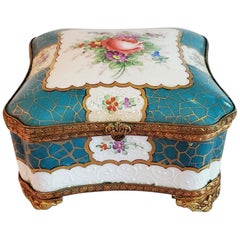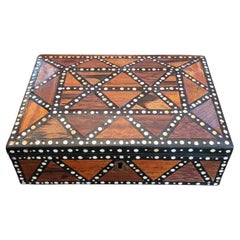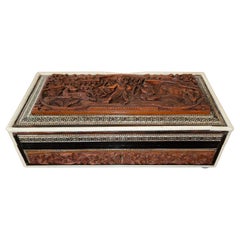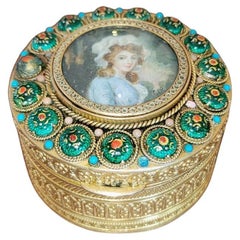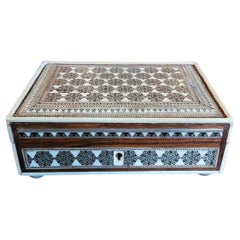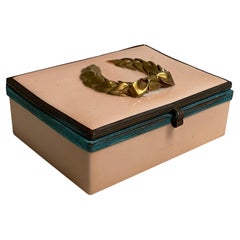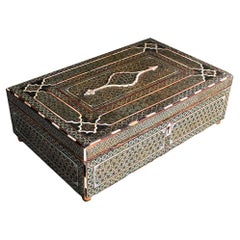Rockwell Antiques Jewelry Boxes
to
7
1
5
1
1
2
5
3
3
3
2
7
4
3
3
3
2
Height
to
Width
to
7
7
7
1
1
19th Century Samson Paris Porcelain Trinket Box
By Samson & Cie
Located in Dallas, TX
Presenting a gorgeous French 19th century Samson Paris Porcelain Trinket Box probably by Edme Samson.
Marked on the base with “Made in France” and unmistakably in the style and manner of Samson.
The lid features hand painted floral bouquets on an ivory porcelain background with gold edging, surrounded by a sky blue lid with gold web or crackling effect.. The lid is hinged and the lid and base are edged in floral gilt metal mounts with Fleur De Lis clasp. It sits on 4 gilt metal or ormolu feet. The sides are likewise hand decorated.
This wonderful antique hand painted box is just bursting with History. Inspired by Edme Samson of Samson & Co., Paris. we believe (based upon the markings and natural aging) that it was made between 1880– 1890 in France and was meant to resemble an antique of a much earlier period. It is very similar to Sevres pieces with it’s color, decoration and design.
Samson specialized in reproducing antiques from the 1600 and 1700s. One of his most interesting works was his Heraldic or Armorial pieces. With this medium sized box, he was not only copying the larger porcelain caskets or coffin boxes...
Category
Antique Late 19th Century French Louis XVI Jewelry Boxes
Materials
Ormolu
19C Anglo Ceylonese Specimen Wood Trinket Box
Located in Dallas, TX
PRESENTING A BEAUTIFUL and RARE 19C Anglo Ceylonese Specimen Wood Trinket Box.
Made in ‘Galle’, Ceylon (now Sri Lanka) circa 1860-80.
Made for the ex...
Category
Antique 19th Century Sri Lankan Anglo-Indian Jewelry Boxes
Materials
Bone, Hardwood, Ebony, Sandalwood
Wedgwood Jasperware Pale Blue Lidded Heart Trinket Box
By Wedgwood
Located in Dallas, TX
PRESENTING A LOVELY Wedgwood Jasperware Pale Blue Lidded Heart Trinket Box.
Made by Wedgwood in England circa 1960 and fully and properly marked/sta...
Category
Mid-20th Century English Neoclassical Revival Jewelry Boxes
Materials
Ceramic
19C Anglo Indian Carved Teak Wood and Sadeli Mosaic Box
Located in Dallas, TX
PRESENTING A LOVELY 19th century Anglo-Indian Carved Teak Wood and Sadeli Mosaic Box, featuring a carving of a Hunt Scene.
Made circa 1870 in Bombay, India during the Rule of the Br...
Category
Antique Late 19th Century Indian Anglo-Indian Jewelry Boxes
Materials
Silver, Pewter
Early 19th Century French Gold Box with Enamel and Miniature Portrait
Located in Dallas, TX
PRESENTING A STUNNING Early 19C French Gold Box with Enamel and Miniature Portrait.
Box made with brass but has been plated with 18ct Gold with beau...
Category
Antique Early 19th Century French Grand Tour Jewelry Boxes
Materials
Gold, Enamel
19C Anglo Indian Bombay MOP Sadeli Mosaic Trinket Box
Located in Dallas, TX
PRESENTING a LOVELY 19C Anglo Indian Bombay MOP (Mother of Pearl) Sadeli Mosaic Trinket Box from circa 1875-85.
Gorgeously detailed and hand-crafted ‘sadeli mosaic’ inlay, from the Bombay Area, with deep greens with silver, pewter, mother of pearl, bone and ebony in geometric patterns.
The box case, is made of sandalwood but completely covered in MOP, bone, faux ivory, ebony and mosaic inlay.
Edged with faux ivory and banded with a different pattern of sadeli mosaic.
Some minor damage to the top (repair is obvious in pics) and ivorine replacements to some edging, but it still a BEAUTIFUL BOX and of real QUALITY!
The mosaic work is FABULOUS!
Box opens to reveal its original blue velvet lining.
It sits on 4 (recently added) silvered button feet.
SADELI MOSAIC: “Anglo Indian boxes were made in India for the English residents from the early part of the 18th century. They were brought back or sent back to England usually by the people who had commissioned them. From the beginning of the nineteenth century they were imported more commercially, although not in any significant numbers until the middle decades. They were very highly valued, especially the early ones, to the extent that the designs were copied on late 19th and early 20th century tins.
The ancient art of Sadeli Mosaic is said to have been introduced from Shiraz in Persia via Sind to Bombay, a long time before the Anglo Indian boxes were made. It was a technique, which required a high degree of skill and patience. It was executed very lavishly, in that the frequent cuts wasted a great amount of the precious materials used. The workmanship was however more than commensurable to the value of the materials.
Ivory, silver, pewter (or other metals), wood and horn were cut into faceted rods which were bound together to form geometric patterns. When the glue has set, the rods were sliced in transverse sections. This gave the maker a number of angled circular pieces in the original pattern. Several variations of patterns could be achieved by combining the materials in different ways. The ivory was sometimes dyed green to give an extra color.
The mosaic pieces in a combination of patterns, often separated by ivory, ebony, horn or silver stringing were used to veneer sandalwood boxes. In the early boxes, which date from the turn of the 18th to the 19th century, there are large panels of mosaic covering tops and sides of boxes. It took incredible skill to cover such large areas without any shakes or wavering of the pattern. The corners and joins on these boxes are impeccably matched.
The makers (reputed to be Persian) of Sadeli mosaic made in the first two decades of the 19th century displayed a total understanding of the qualities of the different materials they used. They combined substances, which can expand and contract according to atmospheric conditions with others, which are hard and unyielding. The result was a sharp definition of the lines and patterns, which made up the whole design.
On the early boxes the designs look deceptively simple. The fact is, they emerged from a culture, which had mastered geometry and understood how to generate a pattern from a set number of points. The patterns are so harmoniously combined that their incredible complexity is not immediately apparent.
The earliest Sadeli boxes...
Category
Antique Late 19th Century Indian Anglo-Indian Jewelry Boxes
Materials
Silver
18th Century French Louis XVI Ring Box with Miniature Portrait of Lady
Located in Dallas, TX
PRESENTING A STUNNING little French Ring Box from the 18th Century, namely a French Louis XVI Brass and MOP Box with Miniature Portrait of Lady.
Box inlaid wi...
Category
Antique Late 18th Century French Louis XVI Jewelry Boxes
Materials
Brass
Related Items
19th Century French Enameled Porcelain Box
Located in Clearwater, FL
A salmon colored enamel box with patina bronze surround and latch and topped with a gold laurel wreath.
Category
Antique 1890s French Decorative Boxes
Materials
Enamel, Bronze
Early 19th Century Persian Wooden Box
Located in London, GB
Early 19th century Persian wooden box
A large Persian wooden box and marquetry called "Khatam Kari" with mosaic decoration of stars and geometric patterns, Middle East origin, early-19th century. This box is in overall good condition considering its age and use, it still has its original silk insert fabric firmly attached which is rare. Khatam kari is a fine and meticulous marquetry work, the oldest examples of which date back to the Safavid era: khatam was then so appreciated by the court that certain princes learned the technique as well as music, painting, or calligraphy. The “Khatam-kari” is therefore the “work of inlays”. This technique consists of making patterns, most often star shapes, by inlaying fine wooden sticks (ebony, Teak, jujube, orange tree, rose), brass (for the golden parts), and camel bone (white parts). The decorated objects are legion: boxes, chess or backgammon games, frames, pipes, desks, or even musical instruments. The khatam can also be associated with the famous Persian miniatures, thus realizing works of art. Coming from techniques imported from China and magnified by Persian know-how, this craft has existed for over 700 years.
Size in inches: H 5” x W 15” x D 9.5”
Age: 1830 - 1850
Origin: Persia
Material: Mixed material
Completely solid in structure and form, aged naturally across all the surfaces. This box does not have a key and therefore cannot be locked, it has had old repairs in blue ink as shown. With one replacement leg...
Category
Antique Early 19th Century Unknown Decorative Boxes
Materials
Wood
Glass & Brass Lidded Trinket Box
Located in San Diego, CA
A fabulous glass and brass lidded trinket box, circa late 1960s..The box is made of a thick clear glass with bronze latch and trim. The set is in ...
Category
Mid-20th Century American Decorative Boxes
Materials
Brass
Light Blue Wedgwood Heart Shaped Trinket Box
By Wedgwood
Located in Guaynabo, PR
This is a light blue Wedgwood heart shaped small lidded box. The top of its lid is decorated with a Greek or Roman relief scene of a woman with a cape co...
Category
20th Century English Neoclassical Decorative Boxes
Materials
Porcelain
Antique French 19th Century Jewelry Box Flap Door Miniature Wood Cabinet
Located in Firenze, IT
This beautiful French late 19th century chest of drawers in black ebonized wood and cherrywood reproduces with perfect proportions in scale a miniature cabinet with three drawers and an upper flap door that opens to reveal a white marble top and an oval mirror inside, nice hand carved band on top with geometrical pattern and molded base.
The black lacquered wood creates a wonderful contrast with the beautiful honey-colored wood grain. Despite its convenient size, extremely detailed, this chest of drawers is equipped with a white Carrara marble top and a small mirror that make it even more special and useful.
The model of a piece of furniture was originally created by cabinet makers to show their skills to the customer and to present the sample of the furniture which would then have been produced on a larger scale. These commode miniatures, along with other specimens, were displayed in the craftsman's workshop to serve as examples to aid the potential client in making a selection. Some also think that these little chests were used as doll and puppets...
Category
Antique Late 19th Century French Empire Jewelry Boxes
Materials
Carrara Marble, Metal
H 11.03 in W 10.24 in D 6.7 in
19th Century Kashmiri Hand Painted Trinket Box
Located in London, GB
19th century Kashmiri Hand Painted Trinket Box
A true work of art, this mid-19th century Kashmiri handcrafted trinket box is covered in beautiful detail.
Including peacocks, birds, flowers, and foliage. The hand painted detail is raised from the box with gold gilded paint and vibrant colours. The box is hinged with its original key and painted orange inside, this example would likely have been owner by a wealthy individual considering the amount of detail and craftsmanship that has gone into creating it, A rare survivor.
Size of inches approx.: H 4” x W 11.5” x D 4.5”
Completely solid in structure and form, with natural wear, loss of surface detail, the paint has worn away over years with damage in areas and loss of detail, The key is present however the lock does not close.
The House of...
Category
Antique 1880s Indian Early Victorian Decorative Boxes
Materials
Wood
Anglo Indian Inlaid Quill Box
Located in Palm Beach, FL
Lofty Anglo Indian hinged box handcrafted in mahogany and decorated with porcupine quills and inlaid bone dots.
Category
21st Century and Contemporary Indian Anglo-Indian Decorative Boxes
Materials
Bone
Wedgwood Jasperware Jewelry Box
By Wedgwood
Located in New York, NY
A small English Wedgwood Jasperware jewelry or trinket box with flower design, circa late-20th century, England. Box is a beautiful matte stonewar...
Category
Late 20th Century English Jewelry Boxes
Materials
Stoneware
Antique 19th Century French Ormolu Beveled Glass Trinket Box
Located in Pearland, TX
A gorgeous antique 19th Century French ormolu glass trinket box, circa 1860. This miniature box has the original tufted silk lining, thick beveled ...
Category
Antique 19th Century French Jewelry Boxes
Materials
Ormolu
Antique Dark Blue Jasperware Wedgwood Round Covered Box
By Wedgewood
Located in Philadelphia, PA
A fine antique Jasper ware round covered box.
By Wedgwood.
In dark blue dip.
Fully marked to the base.
Simply a wonderful box by Wedgwood.
Da...
Category
20th Century British Neoclassical Decorative Boxes
Materials
Ceramic
Wedgwood Jasperware lidded boxes serving bowls classicism Mid-Century England
By Wedgwood
Located in Wien, AT
The set of Wedgwood consists of three lidded boxes in different shape and design and two small serving bowls of which one can be used as an ashtray.
All is made of the famous but r...
Category
Vintage 1980s English Classical Roman Decorative Boxes
Materials
Ceramic
H 4.72 in W 5.71 in D 4.53 in
Huntley Boorne & Stevens Mid Century ‘Wedgwood Jasperware’ Biscuit Tin 1950s
By Wedgwood, Piero Fornasetti
Located in Meer, VAN
Huntley Boorne & Stevens Mid Century ‘Wedgwood Jasperware’ Biscuit Tin, England, mid 20th century. This is a very decorative biscuit tin by Huntley Boorne & Stevens, one of ...
Category
Mid-20th Century Neoclassical Decorative Boxes
Materials
Metal
H 3.15 in W 9.85 in D 9.85 in
